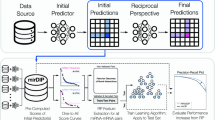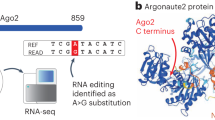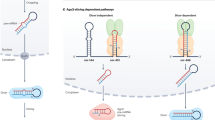Abstract
Computational microRNA (miRNA) target prediction is a field in flux. Here we present a guide through five widely used mammalian target prediction programs. We include an analysis of the performance of these individual programs and of various combinations of these programs. For this analysis we compiled several benchmark data sets of experimentally supported miRNA–target gene interactions. Based on the results, we provide a discussion on the status of target prediction and also suggest a stepwise approach toward predicting and selecting miRNA targets for experimental testing.
This is a preview of subscription content, access via your institution
Access options
Subscribe to this journal
Receive 12 print issues and online access
$259.00 per year
only $21.58 per issue
Buy this article
- Purchase on SpringerLink
- Instant access to full article PDF
Prices may be subject to local taxes which are calculated during checkout


Similar content being viewed by others
References
Ambros, V. The functions of animal microRNAs. Nature 431, 350–355 (2004).
Bartel, D.P. MicroRNAs: genomics, biogenesis, mechanism, and function. Cell 116, 281–297 (2004).
Lagos-Quintana, M., Rauhut, R., Lendeckel, W. & Tuschl, T. Identification of novel genes coding for small expressed RNAs. Science 294, 853–858 (2001).
Mourelatos, Z. et al. miRNPs: a novel class of ribonucleoproteins containing numerous microRNAs. Genes Dev. 16, 720–728 (2002).
Lee, R.C. & Ambros, V. An extensive class of small RNAs in Caenorhabditis elegans. Science 294, 862–864 (2001).
Lau, N.C., Lim, L.P., Weinstein, E.G. & Bartel, D.P. An abundant class of tiny RNAs with probable regulatory roles in Caenorhabditis elegans. Science 294, 858–862 (2001).
Du, T. & Zamore, P.D. microPrimer: the biogenesis and function of microRNA. Development 132, 4645–4652 (2005).
Kim, V.N. & Nam, J.W. Genomics of microRNA. Trends Genet. 22, 165–173 (2006).
Stark, A., Brennecke, J., Russell, R.B. & Cohen, S.M. Identification of Drosophila MicroRNA targets. PLoS Biol. 1, E60 (2003).
Rajewsky, N. & Socci, N.D. Computational identification of microRNA targets. Dev. Biol. 267, 529–535 (2004).
Enright, A.J. et al. MicroRNA targets in Drosophila. Genome Biol. 5, R1 (2003).
Kiriakidou, M. et al. A combined computational-experimental approach predicts human microRNA targets. Genes Dev. 18, 1165–1178 (2004).
Lewis, B.P., Shih, I.H., Jones-Rhoades, M.W., Bartel, D.P. & Burge, C.B. Prediction of mammalian microRNA targets. Cell 115, 787–798 (2003).
Lewis, B.P., Burge, C.B. & Bartel, D.P. Conserved seed pairing, often flanked by adenosines, indicates that thousands of human genes are microRNA targets. Cell 120, 15–20 (2005).
Krek, A. et al. Combinatorial microRNA target predictions. Nat. Genet. 37, 495–500 (2005).
Brennecke, J., Stark, A., Russell, R.B. & Cohen, S.M. Principles of microRNA-target recognition. PLoS Biol. 3, e85 (2005).
Lall, S. et al. A genome-wide map of conserved microRNA targets in C. elegans. Curr. Biol. 16, 460–471 (2006).
John, B. et al. Human MicroRNA targets. PLoS Biol. 2, e363 (2004).
Rajewsky, N. microRNA target predictions in animals. Nat. Genet. 38 (Suppl.), S8–S13 (2006).
Griffiths-Jones, S., Grocock, R.J., van Dongen, S., Bateman, A. & Enright, A.J. miRBase: microRNA sequences, targets and gene nomenclature. Nucleic Acids Res. 34, D140–D144 (2006).
Sethupathy, P., Corda, B. & Hatzigeorgiou, A.G. TarBase: A comprehensive database of experimentally supported animal microRNA targets. RNA 12, 192–197 (2006).
Stark, A., Brennecke, J., Bushati, N., Russell, R.B. & Cohen, S.M. Animal microRNAs confer robustness to gene expression and have a significant impact on 3′UTR evolution. Cell 123, 1133–1146 (2005).
Gupta, A., Gartner, J.J., Sethupathy, P., Hatzigeorgiou, A.G. & Fraser, N.W. Anti-apoptotic function of a microRNA encoded by the HSV-1 latency-associated transcript. Nature 442, 82–85 (2006).
Vella, M.C., Reinert, K. & Slack, F.J. Architecture of a validated microRNA:target interaction. Chem. Biol. 11, 1619–1623 (2004).
Didiano, D. & Hobert, O. Perfect seed pairing is not a generally reliable predictor for miRNA-target interactions. Nat. Struct. Mol. Biol. 13, 849–851 (2006).
Farh, K.K. et al. The widespread impact of mammalian MicroRNAs on mRNA repression and evolution. Science 310, 1817–1821 (2005).
Chan, C.S., Elemento, O. & Tavazoie, S. Revealing posttranscriptional regulatory elements through network-level conservation. PLoS Comput. Biol. 1, e69 (2005).
Megraw, M. et al. MicroRNA promoter element discovery in Arabidopsis. RNA 12, 1612–1619 (2006).
Xie, X. et al. Systematic discovery of regulatory motifs in human promoters and 3′ UTRs by comparison of several mammals. Nature 434, 338–345 (2005).
Bentwich, I. et al. Identification of hundreds of conserved and nonconserved human microRNAs. Nat. Genet. 37, 766–770 (2005).
Berezikov, E. et al. Phylogenetic shadowing and computational identification of human microRNA genes. Cell 120, 21–24 (2005).
Rusinov, V., Baev, V., Minkov, I.N. & Tabler, M. MicroInspector: a web tool for detection of miRNA binding sites in an RNA sequence. Nucleic Acids Res. 33 (Web server issue), W696–700 (2005).
Grun, D., Wang, Y.L., Langenberger, D., Gunsalus, K.C. & Rajewsky, N. microRNA target predictions across seven Drosophila species and comparison to mammalian targets. PLoS Comput. Biol. 1, e13 (2005).
Rehmsmeier, M., Steffen, P., Hochsmann, M. & Giegerich, R. Fast and effective prediction of microRNA/target duplexes. RNA 10, 1507–1517 (2004).
Saetrom, O., Snove, O., Jr. & Saetrom, P. Weighted sequence motifs as an improved seeding step in microRNA target prediction algorithms. RNA 11, 995–1003 (2005).
Acknowledgements
We are grateful for the insightful suggestions regarding this study from the reviewers and many of our colleagues. We thank A. Economides, M. Reczko and K. Essien for their helpful comments on the manuscript, and J. Hirel for his help with the extraction of precompiled target predictions from the web. P.S. is supported by a pre-doctoral US National Institutes of Health training grant (5T32GM008216). P.S., M.M. and A.G.H. are supported by a US National Science Foundation Career Award Grant (DBI-0238295).
Author information
Authors and Affiliations
Corresponding author
Ethics declarations
Competing interests
The authors declare no competing financial interests.
Supplementary information
Supplementary Table 1
Non-conserved TarBase miRNA-target interactions. (XLS 16 kb)
Supplementary Table 2
Benchmark datasets. (XLS 30 kb)
Rights and permissions
About this article
Cite this article
Sethupathy, P., Megraw, M. & Hatzigeorgiou, A. A guide through present computational approaches for the identification of mammalian microRNA targets. Nat Methods 3, 881–886 (2006). https://doi.org/10.1038/nmeth954
Published:
Issue Date:
DOI: https://doi.org/10.1038/nmeth954



